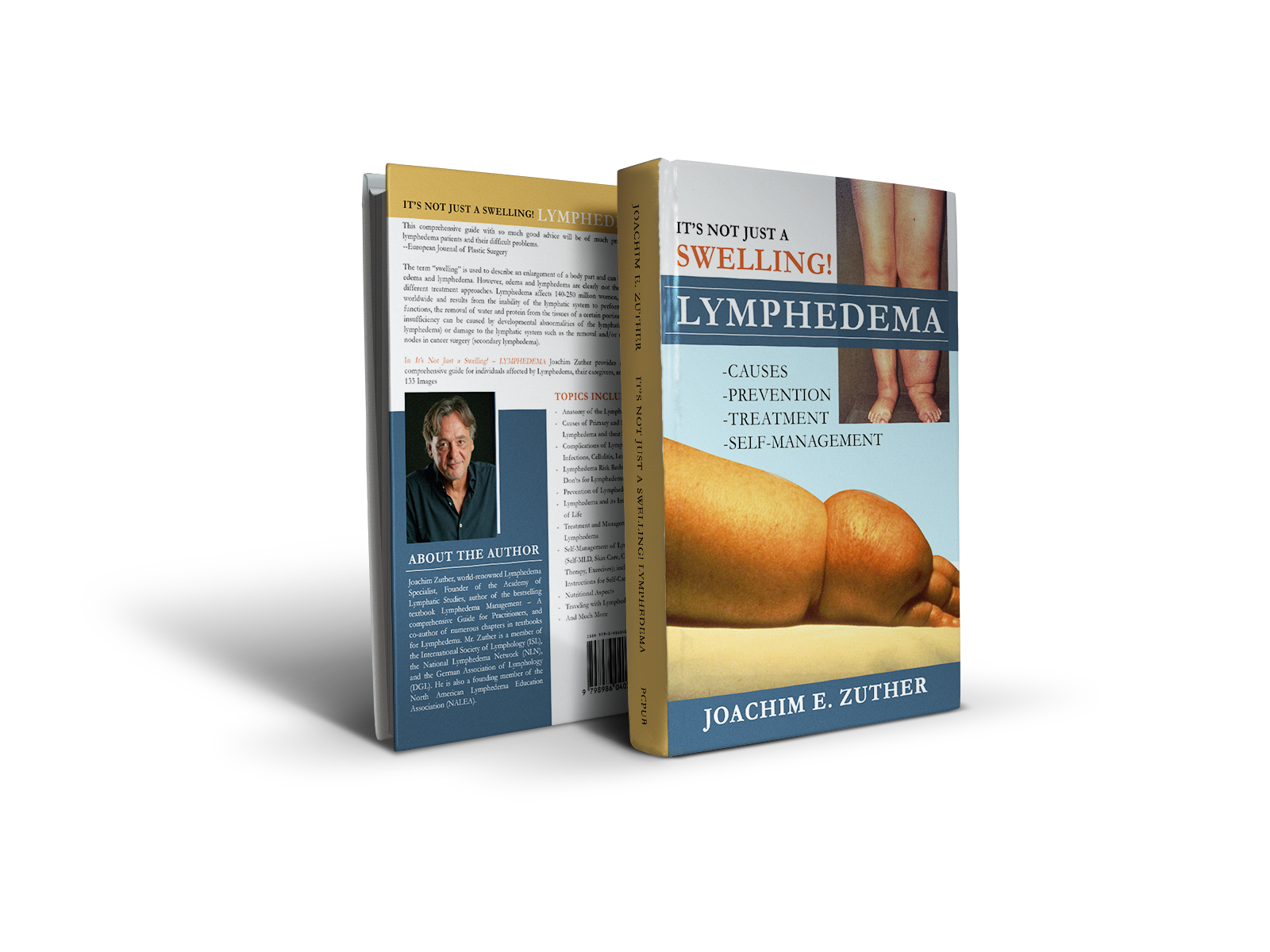New Book for Patients and Caregivers 
In It’s Not Just a Swelling! – LYMPHEDEMA Joachim Zuther provides an up-to-date and comprehensive guide for specifically geared towards individuals affected by Lymphedema, their caregivers, and family members. 133 Images. Paperback and Kindle version
Topics include:
- Self-Management of Lymphedema (Self-MLD, Skin Care, Compression Therapy, Exercises); includes Instructions for Self-Care with images
- Nutritional Aspects
- Lymphedema Risk Reduction, Do’s and Don’ts for Lymphedema
- Complications of Lymphedema, such as Infections, Cellulitis, Leakage
- Lymphedema and its Impact on Quality of Life
- Traveling with Lymphedema
- Prevention of Lymphedema
- Treatment and Management of Lymphedema
- Causes of Primary and Secondary Lymphedema and their Stages
- Anatomy of the Lymphatic System
- And Much More
Click Here to Buy
The Author 
Joachim Zuther, Lymphedema Specialist. Read more |
By Joachim Zuther, on September 19th, 2024
It is important to understand that the elastic fibers in the tissues affected by lymphedema are damaged. These fibers lose their elasticity and tend to harden, which is particularly the case in untreated lymphedema present over a long period of time and progressed stages of lymphedema.
Although the swelling in lymphedema may be reduced . . . → Read More: The Science behind Compression Therapy in Lymphedema Management
By Joachim Zuther, on May 11th, 2024
An IPC is an intermittent pneumatic compression device that is composed of an inflatable garment consisting of multiple pressure compartments that wraps around the arm or leg, and an electrical pneumatic pump that fills the garment with compressed air. The garment is intermittently inflated and deflated with cycle times and pressures that vary . . . → Read More: How do Intermittent Pneumatic Compression Devices (IPC’s) work and what are the Contraindications?
By Joachim Zuther, on February 24th, 2024
A number of patients who underwent axillary lymph node dissection (ALND) in combination with breast cancer surgery experience postoperative pain and limited range of motion associated with a palpable cord of tissue extending from the axilla into the arm on the same side. This condition is known as Axillary Web Syndrome (AWS), or . . . → Read More: Lymphedema Cording (Axillary Web Syndrome)
By Joachim Zuther, on November 2nd, 2023
The primary role of compression garments in lymphedema management is to maintain the reduction of the swelling achieved during the intensive treatment phase of Complete Decongestive Therapy (CDT). A high level of consistency in providing the appropriate compression is crucial in order to avoid re-accumulation of evacuated lymphedema fluid. This consistency is provided . . . → Read More: How to Care for Your Compression Garments
By Joachim Zuther, on August 15th, 2023
“After a day of sitting in the office my ankles are swollen.”
“During the last several months of my pregnancy, my legs practically doubled in size”
“My fingers and hand frequently get puffy following a long hike”
“My arm started swelling after I had surgery for my breast cancer”
“Following the removal of . . . → Read More: When is it Lymphedema? Self-Check for Lymphedema
By Joachim Zuther, on July 25th, 2023
Complete decongestive therapy (CDT), sometimes referred to as complex decongestive therapy, or combined physical therapy is the internationally recognized “gold standard” treatment system for the vast majority of patients affected by lymphedema.
Backed by long standing experience, CDT has shown to be safe and effective as the standard therapy for lymphedema. It is . . . → Read More: Complete Decongestive Therapy in the Treatment of Lymphedema
By Joachim Zuther, on June 23rd, 2023
Chronic lymphedema is considered to be a progressive condition, regardless of its classification of either primary or secondary, and cannot simply be described as an accumulation of protein-rich fluid. It is a chronic, degenerative and inflammatory process affecting the soft tissues, skin, lymph vessels and nodes of the extremities, trunk, abdomen, head and . . . → Read More: Lymphedema and its Impact on Quality of Life
By Joachim Zuther, on April 17th, 2023
Taking appropriate precautions to reduce the risk of developing lymphedema always makes sense. Traveling in airplanes with pressurized cabins at high altitudes, especially on long-haul flights, may have deleterious effects on unmanaged lymphedema. However, individuals affected by, or at risk for lymphedema should not avoid air travel due to fear. Being aware of . . . → Read More: Lymphedema and Airline Travel
By Joachim Zuther, on March 2nd, 2023
The 2016 Yoga in America Study conducted by Yoga Journal and Yoga Alliance shows that the number of yoga practitioners in the United States has increased to more than 36 million, up from 20.4 million in 2012. Yoga, a practice rooted in over 5000 years of ancient Indian texts and traditions, continues to . . . → Read More: Yoga for Lymphedema
By Joachim Zuther, on January 3rd, 2023
Lymphorrhoea is the leakage or weeping of high-protein lymph fluid from the tissues onto the surface of the skin, which usually manifests as beading or trickling of fluid. It is more common in the legs and genital areas, especially if the prolonged restriction in mobility is an issue, but can also affect other . . . → Read More: Leakage of Lymph Fluid, a.k.a. Lymphorrhea
|
Support the Lymphedema Blog This blog is supported by donations. Click to donate today.

Disclaimer The information on this web site is not intended to give medical advice and does not necessarily reflect the opinions of any physicians, nor is it guaranteed to be correct and complete. You should not rely on any information in this web site without seeking the advice of a physician or certified healthcare provider.
|


 Joachim Zuther, Lymphedema Specialist.
Joachim Zuther, Lymphedema Specialist. 
